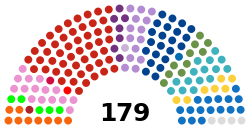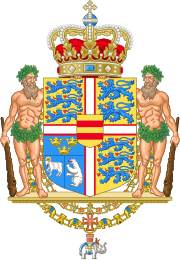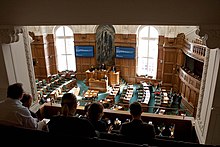Folketing
Parliament of Denmark Folketinget ( Speaker | ||
|---|---|---|
Deputy Speakers | ||
| Structure | ||
| Seats | 179 | |
 | ||
Political groups | Government (86)[1]
Supported by (4) Opposition (89)
| |
| Elections | ||
| Open list proportional representation through the D'Hondt method with a 2% election threshold in constituencies See Elections in Denmark | ||
Last election | 1 November 2022 | |
| Meeting place | ||
 | ||
| Folketingssalen, Christiansborg Palace, Copenhagen | ||
| Website | ||
| thedanishparliament | ||
 |
|---|
The Folketing (
.The Folketing passes all laws, approves the cabinet, and supervises the work of the government. It is also responsible for adopting the state's budgets and approving the state's accounts. As set out in the Constitution of Denmark, the Folketing shares power with the reigning monarch. But in practice the monarch's role is limited to signing laws passed by the legislature; this must be done within 30 days of adoption.
The Folketing consists of
Members are democratically elected by
History
From 1849 to 1953 the Folketing was one of the two houses in the
The Folketing was elected by common vote among men and consisted mainly of independent farmers, traders, and merchants as well as the educated classes. From 1866 to 1915 the right to vote for the Landsting was restricted to the wealthiest, and some of its members were appointed by the king; so it predominantly represented the landed gentry and other conservatives. From 1915 both men and women had the right of vote for both houses, and the Landsting was elected by common vote, although indirectly and with a higher age limit than for the Folketing. During the next decades, law-making mainly took place in the Folketing, and the Landsting came to be regarded as a superfluous rubber stamp.

In 1953 a revised constitution was adopted by
Gaining representation in parliament normally requires only 2% of the national vote. With such a low
Constitutional requirements and electoral system
- Composition of members
- The Folketing consists of 179 members all elected for a four-year term or until the Prime Minister (via the King-in-council) calls for elections, whichever comes first. 175 members are elected in Denmark proper, while Greenland and the Faroe Islands each elect two members in separate constituencies.
- The constitution does not mention political parties at all, although the electoral act does, and MPs are almost always elected for a party. The only independent who has been elected in modern times is the comedian Jacob Haugaard, but independents, usually unknown ones, are seen at every election. Requirements for standing as an independent candidate are much more lenient than for a new party (signatures from 150 eligible voters), but independents are only allowed to contest in a single constituency, making it difficult to gain the needed number of votes for a seat.
- Voting system
- The Constitution requires "equal representation of the various opinions of the electorate", and for regional representation to be secured. The electoral act stipulates the details for this: 135 seats are elected by proportional representation in 10 constituencies, and 40 largest remainder method, and then distributed across electoral provinces with the Sainte-Laguë method and across constituencies with quotients of 1, 4, 7, and so on. Each party may choose among a number of methods for how the seats won by that party are to be distributed among its candidates, with most choosing to use an open list.[8]
- The overall result is proportional to the number of votes cast for each party; however, in rare cases, the largest parties may gain one or two seats extra from smaller parties.
- The voter may vote for a party list, one of the candidates on a party list, or an independent candidate. Voting for a candidate on a party list also gives a vote to that party.
- Parties (usually district party associations) decide on the nomination of candidates before the election. When an open list is used, candidates are elected according to personal votes (including assigned votes). When a relatively closed list is used, only an extreme number of personal votes can change the rank of the list order.
- Parties must either pass the threshold of 2% of the national vote, or gain a constituency seat to gain any supplemental seats. Though very rare, it is possible for a party to gain a constituency seat without getting 2% of the national vote. There is also an esoteric third rule that allows a party to be represented, if it has enough votes in two of the three electoral provinces that the country is divided into. No party has ever fulfilled this rule without getting 2% of the national vote.
- To stand for election, parties that are not currently represented in Parliament must collect signatures of support from approximately 20,000 voters (the number of valid votes cast in Denmark proper at the latest election, divided by 175—the equivalent of one seat; after the 2019 election the required number is 20,195). As of 2016, it is possible to submit and collect signatures digitally.[9]
- Voter requirements
- Denmark has universal suffrage for all citizens 18 years and older who live in the realm and who have not been declared incapable of managing their own affairs. The constitution makes it possible to restrict suffrage for convicted criminals and people receiving social benefits, but this option has not been used for several decades.
- All voters who have not been convicted of criminal acts that makes them unworthy for a seat in the parliament, are eligible. Parliament decides if a member is eligible or not (after their election). Parliament can also decide that an incumbent member is ineligible, if a member is convicted of a crime during a term. This happened after the Impeachment of Inger Støjberg in 2021.


- Parliamentary privileges
- Members enjoy immunity, meaning that no criminal charges may be brought against an MP, unless they are caught red-handed, provided the Folketing does not lift the immunity. The purpose of this is to prevent political persecution. In practice the Folketing has almost always lifted the immunity when a member has been accused of a crime, usually with the consent of the accused member themself.[10]
- Debates can be conducted behind closed doors, although this has not happened since 9 April 1940, day of the German invasion in World War II.
- Ministers
- Ministers may hold a seat in parliament, but they do not need to. Supreme Courtjudges—according to convention—may not hold a seat whilst also acting as judges.
- Ministers may—even if they are not MPs—demand talking time whenever they want.
- Legislating
- Bills may be brought before parliament by members (private member's bills) and ministers. Bills are predominantly brought before parliament by ministers, because they have the Law Office of the Ministry of Justice at their disposal. Instead of putting forward a private bill, the opposition usually put forward a proposal for parliamentary decision, i.e., a short resolution that addresses the subject and directs the relevant minister to propose a bill concerning it.
Forming a parliament
The 179 members of the folketing are directly elected to four-year terms, subject to calls for early elections. All Danish citizens 18 years or older may vote in legislative elections, which are conducted by secret ballot. Folketing seats are allocated among the various parties using the D'Hondt method of party list proportional representation. A party or electoral alliance must pass the election threshold of 2% of the overall vote to be allocated a seat.
Coalition governments
This section needs to be updated. (April 2016) |
The Danish political system is characterised by a fusion of powers, with the government being drawn from the ranks of the Folketing. Denmark is governed by a cabinet and a prime minister who do not have a majority in the Folketing against them (negative parliamentarism).[11] Since no single party in Denmark has had an absolute majority in the Folketing since 1903, in order to pass laws, the prime minister must form alliances with parties outside his or her own party. This either results in a coalition cabinet of multiple parties, or a single-party minority government.
During his first term in 2009 to 2011, Lars Løkke Rasmussen led a centre-right minority government consisting of the Liberal Party (Venstre) and the Conservative People's Party. This coalition government worked with regular parliamentary support from the national conservative Danish People's Party and often gained the necessary 90th seat for majority in the Folketing through negotiations with either the sole MP from the Christian Democrats, Ørum-Jørgensen[12] or another MP outside parties, Christmas Møller, both elected in 2007 as conservative MPs and having defected since then.
Since the
On 13 January 2011 the continuing turmoil in the Conservative group in the Folketing caused Lene Espersen to resign as political leader of the party and focus on her role as
The
Both Margrethe Vestager (Social Liberal Party) and Villy Søvndal (Socialist People's Party) pledged their support to Thorning-Schmidt before the 2011 election.[20] But there has been considerable debate about the future politics of this coalition, mainly because the Social Liberal Party demands a more liberal economic agenda. Also on immigration issues there are political differences between the three coalition parties. This has led some observers to believe that the Social Liberal Party will not join a government coalition but instead opt to be a part of the parliamentary support of a new, centre-left government.[21] In the event the Social Liberals did join the new three-party coalition government formed on 3 October.
Following the 2015 general election, Thorning-Schmidt was replaced as Prime Minister by her predecessor Lars Løkke Rasmussen. Until 28 November 2016,[22] he led a government consisting only of Venstre – a very unusual situation in Danish politics.
Organisation
Speaker
The Speaker is the presiding officer of the Folketing. The Speaker determines which members may speak, and is responsible for maintaining order during debates. The position was created in 1850, and the inaugural holder of the office was Carl Christoffer Georg Andræ. The current Speaker is Søren Gade of Venstre.[23] The Speaker and four Deputy Speakers are elected by MPs at the opening of parliament after each general election and compose presidium of the body.[24]
| Position | Member | Party |
|---|---|---|
| President | Søren Gade | Venstre |
| First Deputy Speaker | Leif Lahn Jensen | Social Democrats |
| Second Deputy Speaker | Jeppe Søe | Moderates |
| Third Deputy Speaker | Karsten Hønge | Green Left |
| Fourth Deputy Speaker | Karina Adsbøl | Denmark Democrats |
Standing committees
The members of parliament are allocated into thirty standing parlimentary committees. The standing committees have a portfolio that covers that of one or more government ministers.[25]
Composition
Demographics
Although Denmark is a representative democracy, a bias is seen in the demographics of the Folketing as opposed to the demographics of Denmark, with middle-aged men over-represented, the Folketing is therefore not a direct representation of the country.
About one-third of seats have been switched for new members every election, a figure that has stayed more or less constant over previous elections. The largest change in these figures was seen in the election of 1973, where 45 percent of seats saw new members, and the lowest change was in the election of 1988, when 14.8 percent of members were newcomers.[26]
Since the incorporation of women into the Folketing in 1915, a general rise in the seats held by women has been observed. In the most recent election in 2022, 78 of 179 seats were held by women.
| Election year | Female members [27] | Percent change | Percentage of Folketing |
|---|---|---|---|
| 1957 | 15 | - | 8,4% |
| 1960 | 17 | +13.3% | 9,5% |
| 1964 | 17 | +0.0% | 9,5% |
| 1966 | 19 | +11.8% | 10,6% |
| 1968 | 19 | +0.0% | 10,6% |
| 1971 | 30 | +57.9% | 16,8% |
| 1973 | 27 | -10.0% | 15,1% |
| 1975 | 28 | +3.7% | 15,6% |
| 1977 | 30 | +7.1% | 16,8% |
| 1979 | 42 | +40.0% | 23,5% |
| 1981 | 42 | +0.0% | 23,5% |
| 1984 | 47 | +11.9% | 26,3% |
| 1987 | 52 | +10.6% | 29,1% |
| 1988 | 52 | 0.0% | 29,1% |
| 1990 | 59 | +13.5% | 33,0% |
| 1994 | 59 | +0.0% | 33,0% |
| 1998 | 67 | +13.6% | 37,4% |
| 2001 | 68 | +1.5% | 38,0% |
| 2005 | 66 | -2.9% | 36,9% |
| 2007 | 67 | +1.5% | 37,4% |
| 2011 | 70 | +4.5% | 39,1% |
| 2015 | 67 | -4.3% | 37,4% |
| 2019 | 70 | +4.5% | 39,1% |
| 2022 | 78 | +11.4% | 43,6% |
Historical composition
Between 1918 and 1920 the Folketing had 140 seats, this was then increased to 149. The number was increased to 179 in 1953, which it remains to this day.
Current composition
See also
- Cabinet of Denmark
- Constituencies in Denmark
- Elections in Denmark
- Elections in the Faroe Islands
- Elections in Greenland
- Inatsisartut – Greenland(Parliament)
- Løgting – Faroe Islands (Parliament)
- List of prime ministers of Denmark
Notes
References
- ^ "Danmark får ny regering: "Det betyder ikke, vi er enige om alt"". Altinget.dk (in Danish). 13 December 2022. Retrieved 13 December 2022.
- ^ Høj, Olivia; Pabst, Mette (25 August 2023). "Efter undren fra Løkke: Jon Stephensen forsvarer, at han beholder sit mandat". dr.dk.
Jon Stephensen siger, at han vil stemme med SVM-regeringen langt hen ad vejen, men han vil ikke love, at han vil stemme med regeringen hver gang.
- ^ Astrup, Peter (20 November 2023). "Regeringen har sikret flertallet: Har lavet aftale med Jon Stephensen". www.bt.dk (in Danish). Retrieved 20 November 2023.
- ^ "About the Danish Parliament". thedanishparliament.dk. The Danish Parliament. Archived from the original on 25 August 2015. Retrieved 23 August 2015.
- ^ "A Minister shall not remain in office after the Parliament has passed a vote of no confidence in him." The Constitution of Denmark – Section 15.
- Berlingske Tidende. 17 June 2007. Retrieved 17 August 2007.
- ^ "The Danish Parliament opens on 6 October". thedanishparliament.dk. Folketinget (The Danish Parliament). Archived from the original on 28 April 2016. Retrieved 13 April 2016.
- ^ [1][permanent dead link] (in Danish)
- ^ Sørensen, Iben; Winther, Bent (12 January 2016). "Vælgererklæringer bliver digitale". Berlingske.dk (in Danish). Retrieved 3 August 2022.
- ^ "Fakta om ophævelse af parlamentarisk immunitet" [Facts about lifting parliamentary immunity] (in Danish). DR. 23 May 2003. Retrieved 8 August 2017.
- ^ "Parlamentarisme / Folketinget". Folketinget (in Danish). 9 January 2017. Retrieved 16 February 2023.
En regering må ikke have et flertal imod sig.
- ^ "Kristendemokraterne vil med i finansloven". Politiken.dk (in Danish). 26 July 2011. Archived from the original on 11 January 2012. Retrieved 16 September 2011.
- ^ "Lene Espersens krise smitter af på Løkke – Politiko | www.b.dk". Berlingske.dk. Archived from the original on 22 July 2012. Retrieved 16 September 2011.
- ^ Af Uffe Tang og Christian Brøndum. "Liberal Alliance redder regeringen – Politiko | www.b.dk". Berlingske.dk. Archived from the original on 25 December 2010. Retrieved 16 September 2011.
- ^ Af Lene Frøslev (13 January 2011). ""Det er den rigtige beslutning" – Politiko | www.b.dk". Berlingske.dk. Retrieved 16 September 2011.
- ^ Af Morten Henriksen og Chris Kjær Jessen. "Både Barfoed og Brian vil afløse Lene – Politiko | www.b.dk". Berlingske.dk. Archived from the original on 16 January 2011. Retrieved 16 September 2011.
- ^ Af Louise Lyck Dreehsen (14 January 2011). "Barfoed taler til pressen – Politiko | www.b.dk". Berlingske.dk. Retrieved 16 September 2011.
- ^ "Rød dominans – Politik". BT.dk. 13 June 2010. Retrieved 16 September 2011.
- ^ "Greens: Markant rødt flertal – dr.dk/Nyheder/Politik". Dr.dk. 2 December 2010. Retrieved 16 September 2011.
- ^ "Vestager peger på Helle Thorning". Borsen.dk. 20 October 2008. Archived from the original on 19 July 2011. Retrieved 16 September 2011.
- ^ "Radikale med i regering – hvis ... – dr.dk/Nyheder/Politik". Dr.dk. 19 August 2010. Retrieved 16 September 2011.
- ^ "Denmark PM strikes deal to form new government". Deutsche Welle. Retrieved 13 February 2017.
- ^ "Nu er Søren Gade valgt som Folketingets formand | Nyheder". DR (in Danish). 16 November 2022. Retrieved 16 November 2022.
- ^ "The Speaker". Thedanishparliament.dk. Archived from the original on 25 August 2015. Retrieved 23 August 2015.
- ^ "About the parliamentary committees". The Danish Parliament. 31 January 2019. Retrieved 11 December 2023.
- ^
Folketinget (book). Denmark: Gyldendal. 16 June 2022. p. 179. ISBN 978-87-02-26493-7.
- ^ "Tal og fakta om Folketinget / Folketinget" (in Danish). 24 November 2016. Retrieved 29 May 2023.
External links
- Official website (in English)
 Media related to Folketinget at Wikimedia Commons
Media related to Folketinget at Wikimedia Commons- The Danish Parliament at Google Cultural Institute
- Klint, Thorkil; Evert, Anne Sofie; Kjær, Ulrik; Pedersen, Mogens N.; Hjorth, Frederik (2023). "The Danish legislators database". Electoral Studies. – a database of members of Folketinget for every electoral term since its inception in 1849.

